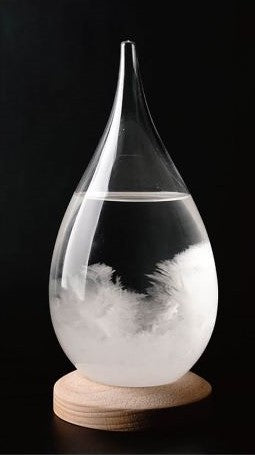Fitzroy Storm Glass
Fitzroy Storm Glass
Couldn't load pickup availability
Frizroy Storm Glasses was named after the English Royal Navy officer and scientist Robert FitzRoy. It was used to predict weather in the 1860s but now mostly serve as home or office decorations. Its unique chemistry attracts many curious minds, making it a perfect home and office decor.
Storm glasses contain a mixture of chemicals which are said to crystallize in a way that makes it possible to predict weather conditions several days in advance, typically one to three days.
The storm glass was popularized by Admiral Robert Fitzroy
At the time that storm glasses first appeared (sometime in the 1700s), barometers—a reasonably accurate way to predict the future weather—remained relatively expensive. Most had to rely on cheaper methods of weather prediction, so sometime in the 17th Century an unknown inventor created the storm glass, but we don’t know why or how they did it. They would eventually rise in popularity in the mid-1800s after British Naval Officer Admiral Robert Fitzroy used them aboard the HMS Beagle, which also happened to host a young Charles Darwin doing his initial research on evolution. This is why the storm glass is often called an Admiral Fitzroy Storm Glass.
Admiral Fitzroy was a weather enthusiast, and over the course of his expeditions, he examined the behavior of a storm glass to better understand how it worked. The relationship between the liquid’s behavior and the corresponding weather conditions used today derive from Fitzroy’s work aboard the Beagle.
Fitzroy became so enamored by the storm glass that he pushed for their use throughout the UK to help early meteorologists predict the weather better and more so after an 1859 storm which took many by surprise, resulting in hundreds of deaths at sea.
Storm glasses fell out of favor late in the 19th Century as mercury barometers became more affordable. These days, they have become little more than a conversation piece, rather than weather predictors, and many may not even know that such a device ever existed.
Storage Instructions:
Avoid direct sunlight; preferably to be placed in dark areas of a room
8.25"H (21cmH)
|
Storm Glass Liquid Appearance |
Weather Forecast |
|---|---|
|
Cloudy with small stars |
Thunderstorms |
|
Clear |
Sunny and fair |
|
Small, isolated stars during winter |
Sunny and fair weather followed by snow in 1-2 days |
|
Large, isolated flakes |
Cloudy and humid, snow in the winter |
|
Flakes which rise and stay in the upper part of tube |
Winds in the atmosphere, changeable weather |
|
Cloudy |
Rain or rain soon |
|
Strands forming near the top |
Windy |
|
Small floating spots |
Fog |
|
Crystals at the bottom |
Frost |


